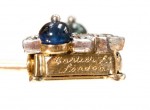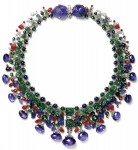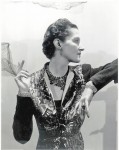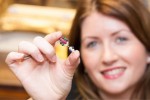 A “Tutti Frutti” Art Deco Cartier brooch found in a £38 ($60) box of costume jewelry sold at auction on Friday for £10,800 ($17,550). The anonymous seller bought the box at a tabletop sale in Staffordshire, not realizing that there was a tiny treasure inside.
A “Tutti Frutti” Art Deco Cartier brooch found in a £38 ($60) box of costume jewelry sold at auction on Friday for £10,800 ($17,550). The anonymous seller bought the box at a tabletop sale in Staffordshire, not realizing that there was a tiny treasure inside.
The brooch has a central ruby engraved with a stylized flower growing from two leaves. On either side of the ruby are three alternating cabochon emeralds and sapphires. Underneath the ruby are four pavé diamonds in a platinum geometric Tetris-like setting. A slender gold pin connects the ruby top to a base of six pavé diamonds flanked by two cabochon sapphires. The piece is signed “Cartier, London.”
 Cartier’s “Tutti Frutti” line has become one of its most famous styles. It debuted in the 1920s, a dramatic break from the severe geometries and monochromatic emphasis of Art Deco. Officially named “pierres de couleur” (colored stones), the style was inspired by traditional Indian jewels and the same floral patterns of the Moghul emperors that inspired those gorgeous chintz textiles I wrote about recently. Cartier had done business in Indian since Pierre Cartier was commissioned by Queen Alexandra to make an Indian-style necklace from several pieces in her collection. Cartier London thus became the center of work in Indian gemstones and design.
Cartier’s “Tutti Frutti” line has become one of its most famous styles. It debuted in the 1920s, a dramatic break from the severe geometries and monochromatic emphasis of Art Deco. Officially named “pierres de couleur” (colored stones), the style was inspired by traditional Indian jewels and the same floral patterns of the Moghul emperors that inspired those gorgeous chintz textiles I wrote about recently. Cartier had done business in Indian since Pierre Cartier was commissioned by Queen Alexandra to make an Indian-style necklace from several pieces in her collection. Cartier London thus became the center of work in Indian gemstones and design.
 Jacques Cartier, head of the London office, traveled to India in 1911 and was so struck by what he saw there that he soon integrated Indian style and gemstones into the company’s jewels. Agents in India bought gemstones, among them vintage stones carved with the leaf, flower and berry shapes characteristic of the Moghul period. Cartier’s designers in Paris, New York and London took the Indian stones and mixed them with the white diamond severity of Art Deco to create uniquely colorful patterns that injected naturalism and color into Art Deco shapes.
Jacques Cartier, head of the London office, traveled to India in 1911 and was so struck by what he saw there that he soon integrated Indian style and gemstones into the company’s jewels. Agents in India bought gemstones, among them vintage stones carved with the leaf, flower and berry shapes characteristic of the Moghul period. Cartier’s designers in Paris, New York and London took the Indian stones and mixed them with the white diamond severity of Art Deco to create uniquely colorful patterns that injected naturalism and color into Art Deco shapes.
 Society fashion plate and Singer sewing machine heiress Daisy Fellowes had a famous example custom made by Cartier in 1936. It was called the Collier Hindou and she bought it as a consolation prize for herself after the hardships of the Depression forced her to sell her yacht. (I guess that’s the insanely rich version of a breadline.) The necklace became known as the Tutti Frutti, but according to Cartier, the style itself wasn’t given the name until 1970. According to British Museum curator and Cartier expert Judy Rudoe, the “pierres de couleur” style became known as “Tutti Frutti” colloquially in the 1940s, probably inspired by bakelite fruit jewelry popularized by Carmen Miranda and her Tutti Frutti hat.
Society fashion plate and Singer sewing machine heiress Daisy Fellowes had a famous example custom made by Cartier in 1936. It was called the Collier Hindou and she bought it as a consolation prize for herself after the hardships of the Depression forced her to sell her yacht. (I guess that’s the insanely rich version of a breadline.) The necklace became known as the Tutti Frutti, but according to Cartier, the style itself wasn’t given the name until 1970. According to British Museum curator and Cartier expert Judy Rudoe, the “pierres de couleur” style became known as “Tutti Frutti” colloquially in the 1940s, probably inspired by bakelite fruit jewelry popularized by Carmen Miranda and her Tutti Frutti hat.
 Tutti Frutti pieces go for millions of dollars today. They are highly sought after by jewelry collectors so much so that even tiny little brooches in Derbyshire auctions draw bidders from all over the world and exceed their pre-sale estimates by more than £2,000.
Tutti Frutti pieces go for millions of dollars today. They are highly sought after by jewelry collectors so much so that even tiny little brooches in Derbyshire auctions draw bidders from all over the world and exceed their pre-sale estimates by more than £2,000.
Ah! You fortunately, blessed, privileged lucky British! You have such rich everything! History, culture, art’s and literature.
I do not believe my envy could be any higher than it is now.
Bless you all,
-Tom
Huh. I’d never known that Cartier had shifted from art deco to jazz deco at any point. This makes me want to take a closer look at their fountain pens again. Was there a similar shift in those?
Perhaps Cartier could look through their curated design sketches for date and provenance of the piece (if one were so inclined).
Happily, Cartier has now restored this Jabot pin. The delightful example of Tutti Frutti spent many months at Cartier, London followed by several more at Cartier, Paris before being returned according to its original design. Notably, a sapphire in the lower box was replaced by an emerald.
The piece is beautiful and lovingly appreciated as one of the most iconic designs in our humble collection.